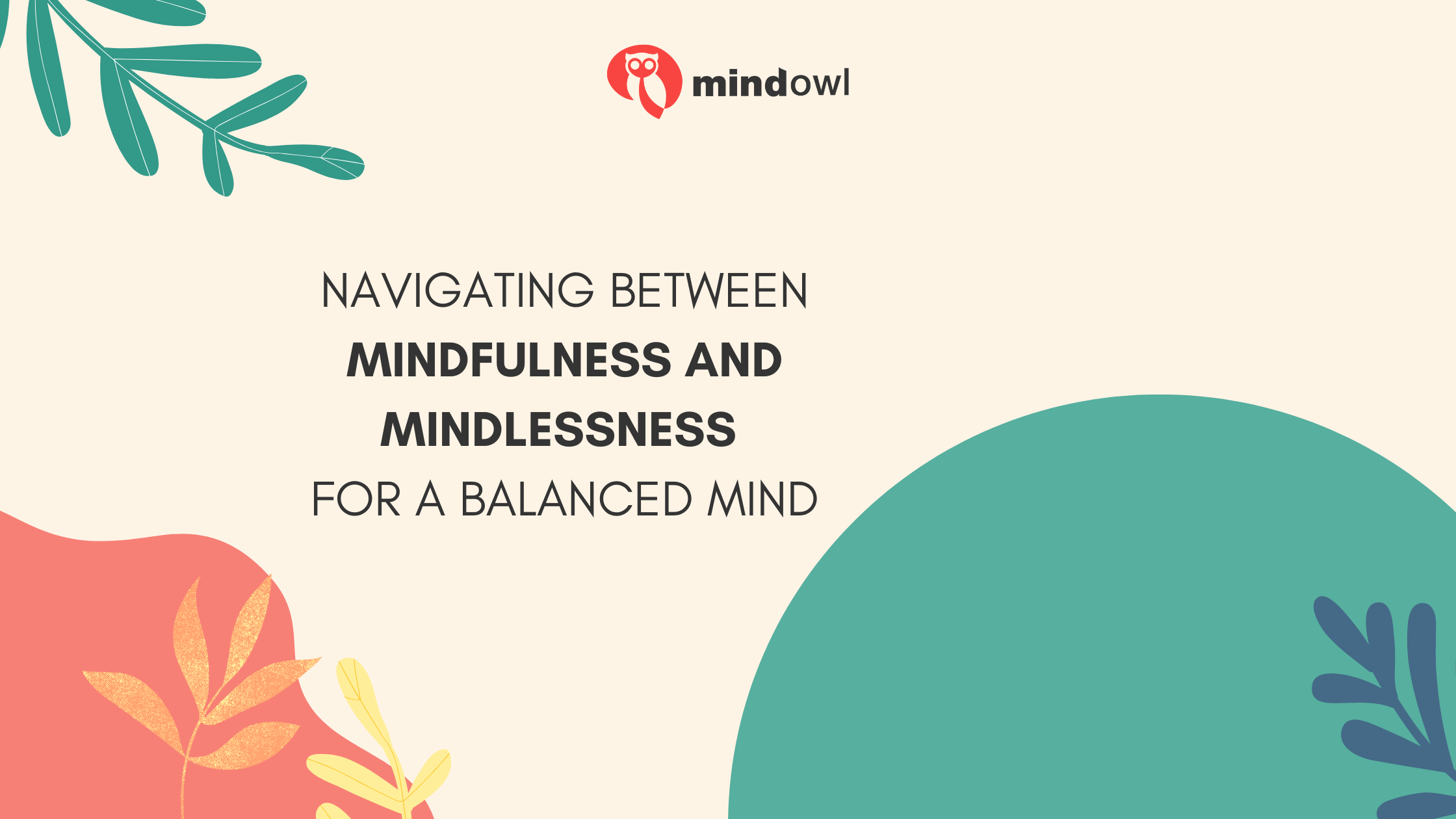Do you ever find yourself zoning out during daily tasks, or perhaps getting through the day on autopilot? You’re not alone. This common experience ties into two concepts that influence how we engage with the world: mindfulness and mindlessness.
Interestingly, while many of us strive for more mindful moments, psychology suggests there’s a place for being mindless too.
Mindfulness means paying close attention to what’s happening in the present moment without judgement. It’s about noticing new things and being engaged. On the flip side, mindlessness is when our thoughts and actions run on autopilot—like driving to work without remembering the journey.
Ellen Langer, a professor in psychology, points out that both states have their benefits depending on the situation. Our article explores these concepts further, offering insights into how balancing both can improve well-being.
Ready to learn more? Keep reading!
Key Takeaways
- Mindfulness is about being aware of your emotions and staying present, noticing details around you like the sound of leaves or the feel of sunlight.
- Mindlessness leads to forgetting small details in our daily life, making us feel disconnected and not fully present.
- Practicing mindfulness allows for better decisions by being more aware of options and feelings, while mindlessness can save mental energy for important tasks.
The Essence of Mindfulness

Mindfulness involves being aware of your emotions and staying present in the moment. It also encompasses paying attention to what you’re doing without letting your thoughts drift.
Emotional Self-Awareness
Emotional self-awareness is all about knowing what you’re feeling. This understanding links directly to mindfulness and emotional intelligence, making it easier for people to handle their emotions.
When someone recognises their emotions, they can react to situations with thought rather than just impulse. They see what makes them tick and why, helping them make choices that are in line with their values and goals.
Having this kind of awareness lets a person notice the art of seeing things anew each day, even in routine actions like brushing your teeth or riding a bike. It’s key for maintaining a healthy mind-state, allowing individuals to focus fully on the present moment without being distracted by past or future worries.
This skill doesn’t come overnight but grows stronger with practices such as meditation and mindful attention exercises, which heighten one’s sensitivity to personal motivations and feelings.
Presence in the Moment
Being here now is what mindfulness teaches us. It’s like turning up the volume on life’s movie. You see more, hear more, and feel more of everything around you. Every detail counts, from the sound of leaves rustling to the way sunlight dances on your skin.
This full awareness brings a special kind of care to our actions and reduces stress that we don’t need.
To practice being in this moment, you don’t have to sit still with your eyes closed. Mindfulness happens when you truly listen to a friend, savor each bite of your meal, or even notice new things during a regular walk home.
It’s about waking up from auto-pilot mode and immersing yourself into the present experience with all your senses wide open.
The Nature of Mindlessness

Mindlessness can lead to habitual forgetfulness and challenges in focus. It might even result in learned helplessness in extreme cases. Mindlessness is a state that warrants careful consideration when navigating everyday life for optimal mental wellbeing.
Habitual Forgetfulness
Forgetting things often becomes a big problem. It makes it hard for us to stay on top of our daily tasks and responsibilities. This kind of forgetfulness isn’t just about losing keys or forgetting names.
It’s about not noticing the details in our day-to-day lives, which can make us feel disconnected and out of touch.
Mindlessness leads to this habit. When we act without thinking, we miss out on the richness of life around us. Our minds might be stuck in past events or worrying about future ones, so we overlook what’s happening right now.
This keeps us from being fully present and can even affect how well we remember happy moments.
Living in the moment helps you notice more around you, reducing habitual forgetfulness.
Challenges in Focus
Keeping focus can be tough when our brains love to switch on autopilot. Habitual actions, like brushing teeth or checking emails, often slide us into mindlessness. We do these activities without really thinking about them.
This means we’re not fully present in our lives at those moments. Our thoughts might drift to the past or future, making it hard to stay mindful.
Repeating the same tasks every day can also make it difficult for us to notice what’s happening right now. We might struggle to pay attention during conversations or miss out on the little things that make life special.
Learning how to break this cycle of automatic behavior is key if we want to interact more mindfully with the world around us and enhance our cognitive well-being.
Mindfulness and Mindlessness in Everyday Life
Mindfulness and mindlessness affect how we live each day. Being mindful means paying attention to what you’re doing, whether at work or home. It’s like noticing the colors of a painting in a gallery – every detail stands out, making the whole experience richer.
On the other hand, being mindless often looks like going through motions automatically without really thinking about them. This can happen when you eat without tasting your food or rush through tasks just to get them done.
In daily life, mindfulness can lead to better decisions because you’re more aware of your options and feelings. Imagine deciding calmly instead of reacting on impulse during a stressful moment at work.
Mindlessness has its place too; it lets us perform routine tasks without using up mental energy needed for important things. Like driving the same route home so often that you don’t have to think about each turn anymore, allowing you to ponder over other matters safely as you navigate traffic.
Both states have their benefits but knowing when to engage in one over the other is key for a balanced life.

Conclusion: Balancing Mindfulness and Mindlessness for Wellbeing
Balancing between being mindful and living on autopilot needs a bit of thought. Sure, paying attention to the present helps us enjoy life more fully. But sometimes, letting our minds run on autopilot makes tasks easier and saves mental energy for bigger challenges.
Think about it – practicing meditation can calm your thoughts, while not sweating the small stuff keeps you from feeling overwhelmed. Finding the right mix can lead to a happier, healthier life where you’re engaged with the world yet not drained by its demands.
Remember, it’s all about finding what works best for you in various situations.
FAQs
1. What’s the main difference between mindfulness and mindlessness?
Mindfulness is all about being fully present in the moment, noticing new things, and paying attention to your surroundings. On the other hand, mindlessness involves going through actions without much thought — think of it as running on autopilot.
2. Can being mindless ever be a good thing?
Yes, actually! While mindfulness encourages us to immerse ourselves fully in our activities and thoughts about the present, scientific research has shown that in certain situations, like performing well-practiced skills or when needing a break from intense focus, being mindless allows our minds to take shortcuts and rely on instinct.
3. How does mindfulness meditation work?
Mindfulness meditation is a practice where you focus on your breathing and bring your attention back to the present whenever your mind starts wandering. It’s not just sitting quietly; it’s an active effort to be aware of your thoughts and feelings without any judgement.
4. Why do some people prefer mindfulness over mindlessness?
People who favor mindfulness often find that it helps them reduce stress by focusing on what’s happening right now rather than worrying about what could happen in the future or dwelling on things from the past. It can also improve concentration and increase happiness by encouraging appreciation for current experiences.
5. Is there scientific support for mindfulness?
Absolutely! Harvard University studies have shown that regular mindfulness practices can lead to changes in brain regions associated with memory, self-awareness, empathy, and stress reduction among others.
6. How can I start practicing mindfulness or mindlessness effectively?
To practice mindfulness effectively: start small with daily meditation sessions focusing solely on your breath or surroundings; try engaging deeply with everyday tasks by noticing new aspects of these activities each time; reflect regularly on how these practices affect your mood and productivity.
For embracing beneficial aspects of mindlessness: allow yourself times when you engage in repetitive tasks without overthinking them – this might include doodling while listening to music or going for walks where you let your instincts guide you rather than planning every route ahead of time.
MindOwl Founder – My own struggles in life have led me to this path of understanding the human condition. I graduated with a bachelor’s degree in philosophy before completing a master’s degree in psychology at Regent’s University London. I then completed a postgraduate diploma in philosophical counselling before being trained in ACT (Acceptance and commitment therapy).
I’ve spent the last eight years studying the encounter of meditative practices with modern psychology.


